NOTE: With all of the answers below, If you have an alternate opinion about any one, please share! We are all here to learn from each other. Even the most experienced trackers continue to expand their knowledge through their own and others’ experiences, so don’t hesitate to share additional information, observations, questions, or experience.
There are 10 questions in this quiz, the first 5 are from the northeastern USA, and the second 5 are from South Africa. More exact locations are given with the individual questions.
Question 1.
This photo comes from Shane Hawkins in southwestern New York, USA.
Who or what is it? Describe what you see.
Scroll down for the answer.
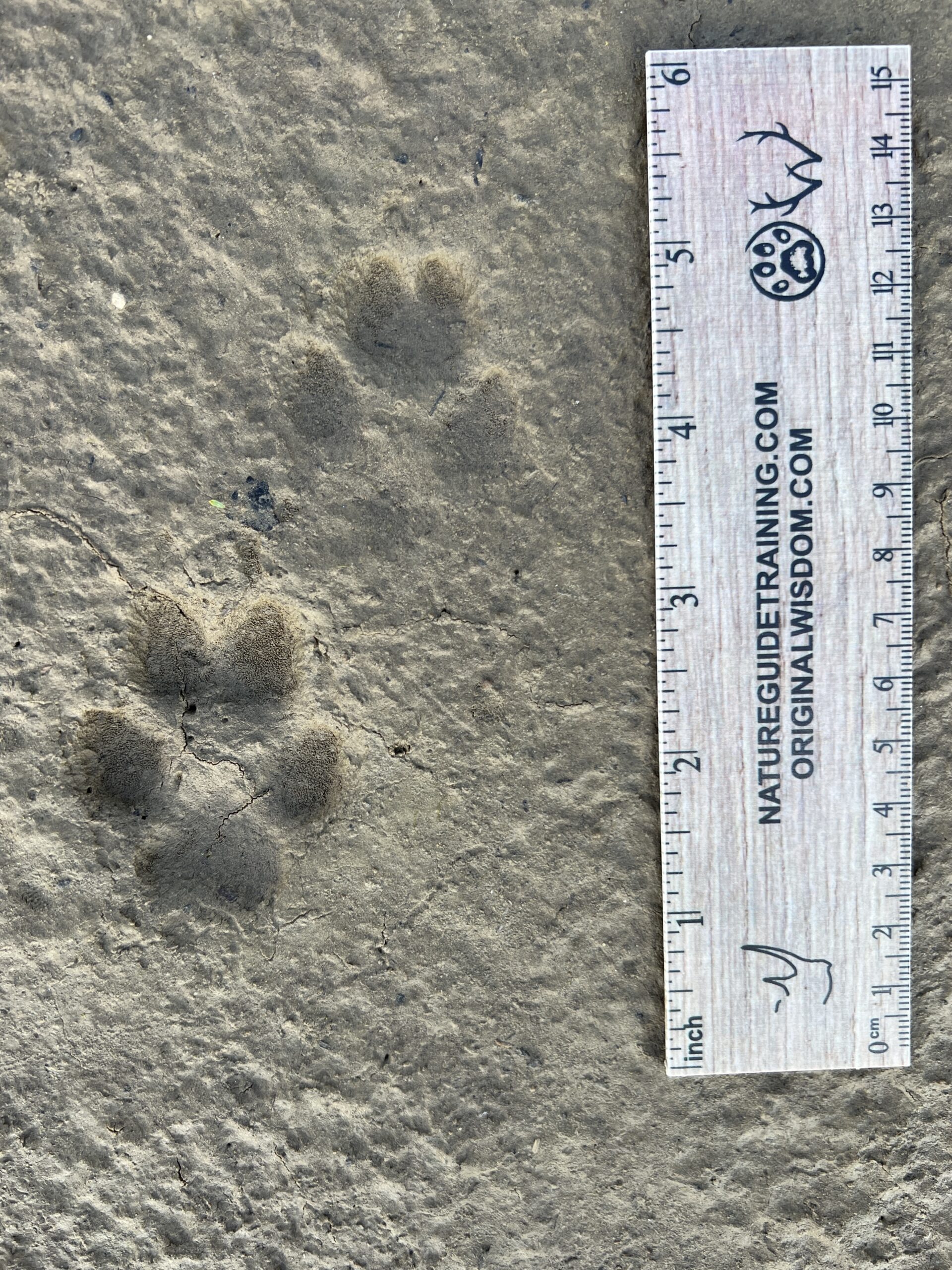
Answer: Many people got to some kind of canine on this. Melinda came closest to our “suspected answer” with “Front foot is just about 2” long, hind foot about 1 ¾”. 4 toes, triangular palm pad in front foot, barely registering metatarsal pad in hind foot. Large amount of X-shaped negative space, furry, no claws. It’s at the large end for gray fox, and about the right size for red fox, but it is hard to detect a chevron in the heel pads.” The chevron that Melinda mentions is a common identifying feature in the meta-pads of red fox tracks. Shane Hawkins took this photo on the Allegheny mud-flats near her home, where she identifies tracks and signs almost every day. She explained, very well, her logic for these tracks belonging to a grey fox. I (Kersey Lawrence), initially called it a red fox, and Sandy Reed initially called it a coyote. We conferred and even discussed the possibility of “weird-little-domestic-dog.” They are too small for coyote (unless it’s a small one). Shane says that there are all three of the wild species mentioned present on the mud-flats (and domestics), but that red foxes usually show lots of distinct fur and a prominent bar (chevron) in both the front and hind tracks in that excellent silty substrate. She had a couple more photos from that day, but nothing any more revealing. When I look again, I can see grey fox characteristics, the “H” shaped negative space, large-ish toes, small claws. etc., and I can accept grey fox – but we all agreed that we are not 100% positive. Which makes this an excellent example of the care it takes to choose a representative photo for a quiz, or a question for an evaluation. At least, in-person, we can walk around and look at further evidence!
Question 2.
This photo comes from Shane Hawkins in southwestern New York, USA.
Who or what is it? Describe what you see.
Scroll down for the answer.
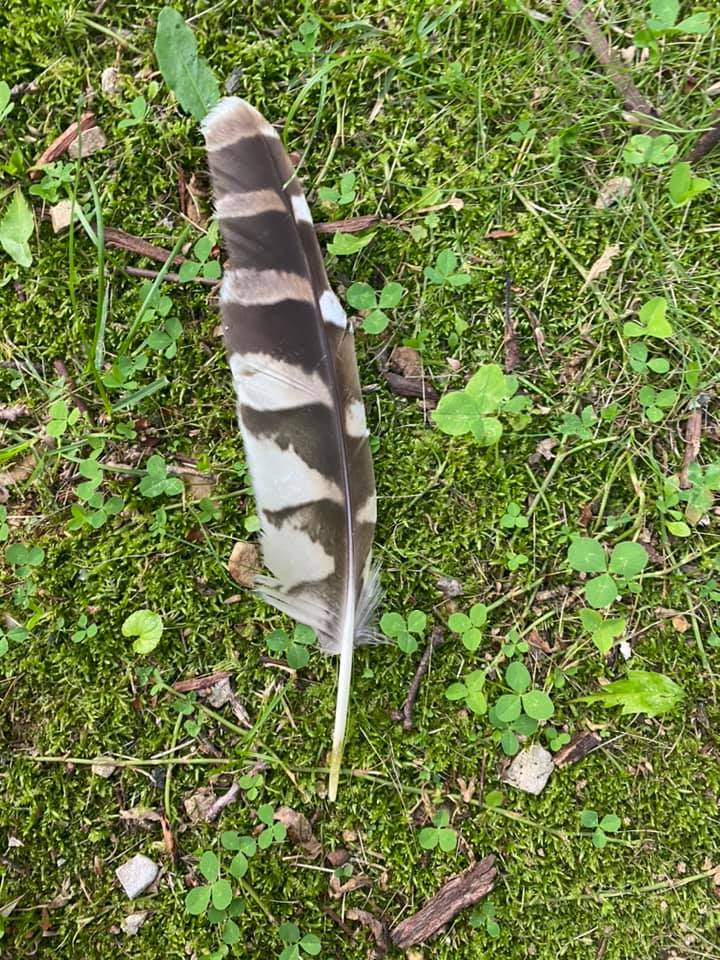
Answer: Everyone got to feather, from a bird, with this one, which is a good start! Some folks only said that it was a wing feather, or a tail feather, and we got answers with both sides of the body identified, left and right. Answers included: owl (barred or great-horned), turkey, buzzard, pheasant, and northern goshawk. The “soft” edges of this should lead you towards an owl’s feather. All of those other birds mentioned have crisper, more delineated edges to their feathers. Owl feathers are soft to decrease the noise they make as they fly to catch prey. They rely on stealth, not speed. You can check a number of resources to get to the species. There is the Feather Atlas, FeatherBase, or even Casey McFarland’s and S. David Scott’s Bird Feathers – A Guide to North American Species. This is a Barred Owl feather. The emargination of the narrower side of the feather, and the drastic difference in width between the left and right side of the rachus (vein) tells us that this is a primary wing feather. We need to angle it 90 degrees to the left, to aim the shorter edge into the wind, making this a left primary wing feather of a barred owl.
Question 3.
This photo comes from Shane Hawkins in southwestern New York, USA.
Who or what is it? Describe what you see.
Scroll down for the answer.
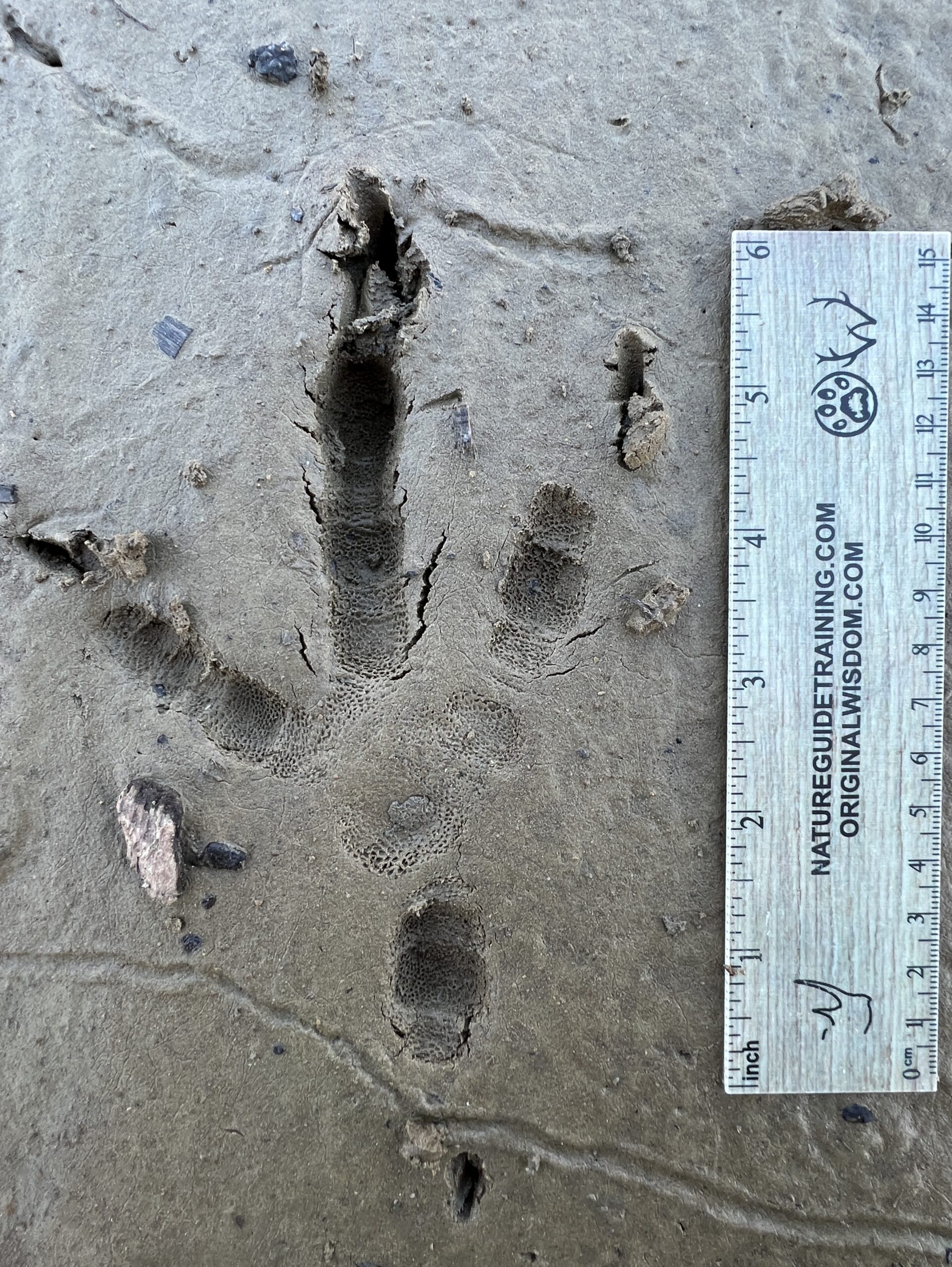
Answer: Oh. My. Word. Would you look at that pebbling in this big, bird track?!? The texture is fantastic. Every detail shows. And did we say it’s big? Including claws its over the length of the 6 inch ruler. And those claws – they are very big and very sharp, indicating that this is a bird that can catch prey. This bird is an eagle, a bald eagle! Pete, Erin and Mark all got this one. There were a number of answers for heron. Heron tracks are big, but they don’t have those long, sharp, robust claws, and they have longer, thinner toes, where the hallux (hind toe) is long and “in the same plane as toe 3 (the middle, forward facing toe), but offset – so going in exactly the same direction but as if someone had picked it up and placed it to the left or the right of that central toe 3.” I don’t see distinct lobing from the toe bones in heron tracks, or this kind of pebbling, either.
Question 4.
This photo comes from Shane Hawkins in southwestern New York, USA.
Who or what is it? Describe what you see.
Scroll down for the answer.
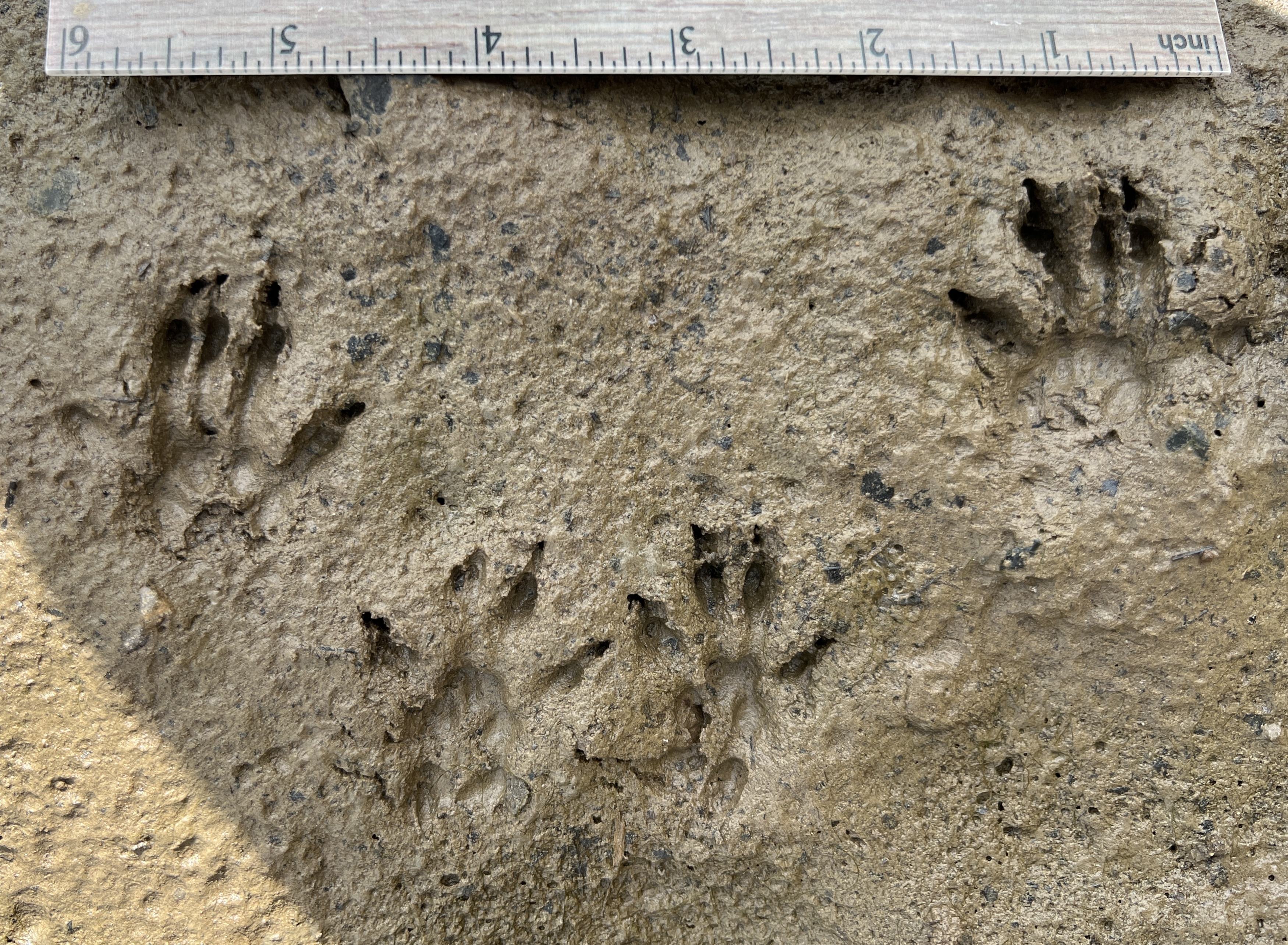
Answer: My favorite answer came from Juca, who said, “If it is not a squirrel I will retire from this thing.” Well, Juca, you don’t have to retire. The most complete answer came from Pete, who said, “Looks like squirrel pattern. Two hind feet at top of track—-1-3-1 pattern of toes and front feet at bottom of image with 4 toes each. Sharp claws and 5 round circles on palm pads. Large size makes me guess gray squirrel.” Perfect. This is a slow bounding pattern from a grey squirrel.
Question 5.
This photo comes from Shane Hawkins in southwestern New York, USA.
Who or what is it? Describe what you see.
Scroll down for the answer.
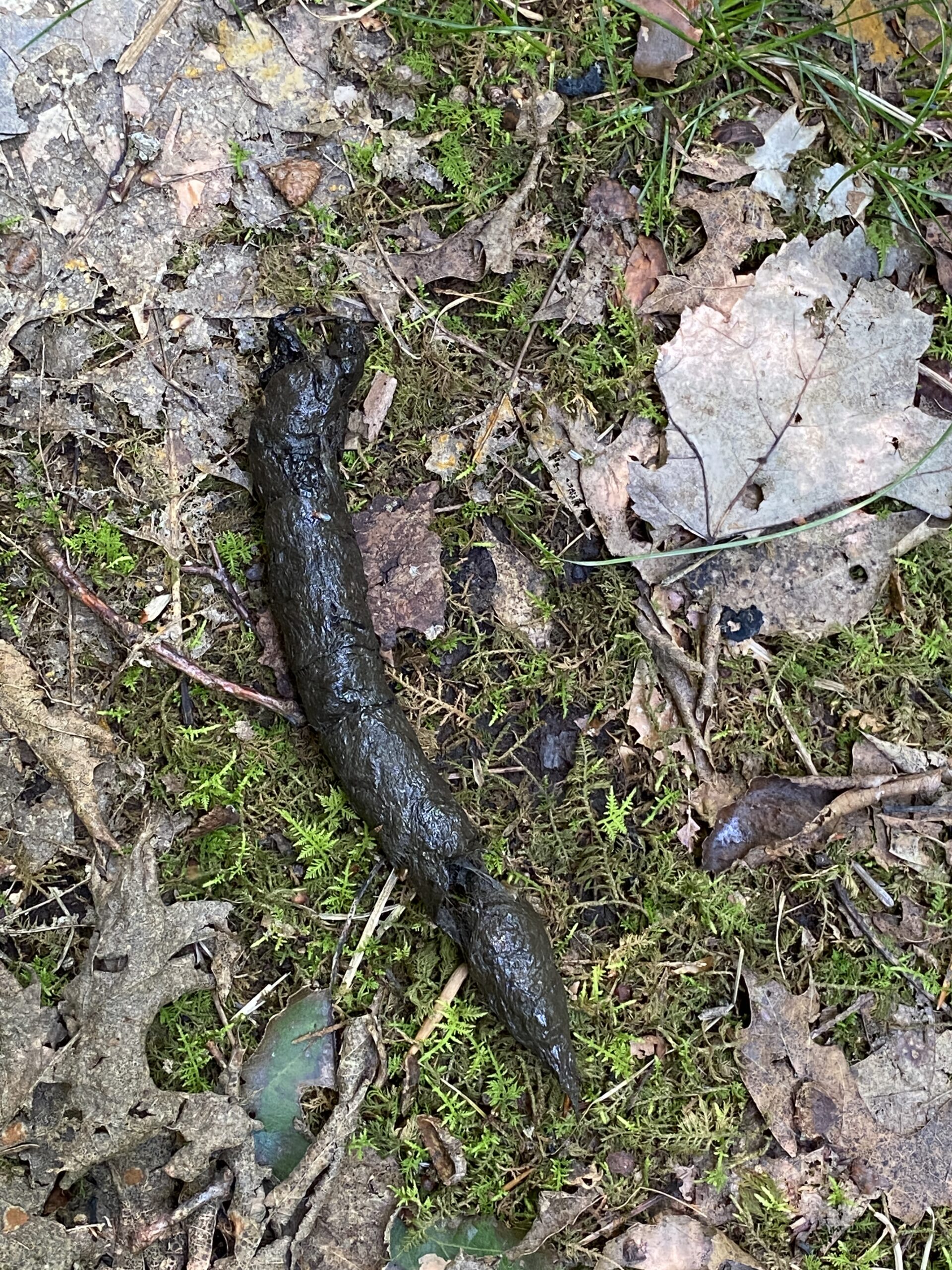
Answer: No one got this one, probably because it’s a little atypical. I would have liked to smell it, and poke it with a stick, haha! I’ll bet it smells like a kitty-litter box, and that it is hard to poke. The content looks like fur (one of the reasons it’s so hard to poke), and the black color indicates a meat diet. That glossy sheen is indicative of cat scat, and the fur and size, and the fact that it’s unburied, lead us towards bobcat in southwestern NY. Usually, we see more ball and socket shaped scats for bobcats, with one tapered end (visible here). Domestic or feral cats often bury, or half-bury their scats.
Question 6.
This photo comes from Kersey Lawrence, from the Welgevonden Nature Reserve in the Waterberg Mountains of South Africa.
Who or what is it? Describe what you see.
Scroll down for the answer.
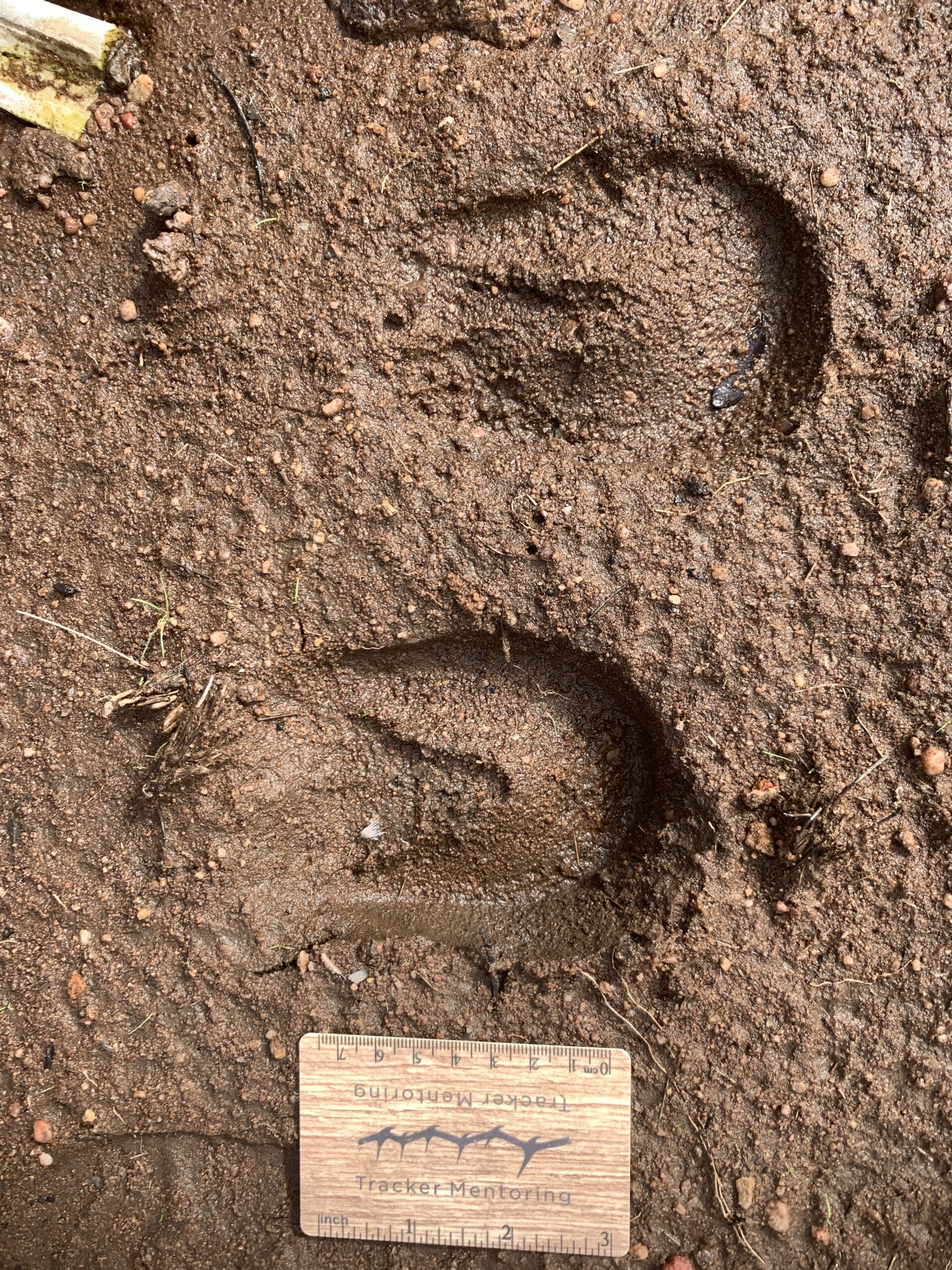
Answer: Lots of you got this one correct! It’s a single toed, hoofed animal in Africa. We only have one (but on some reserves we do also have trail riding horses, whose tracks are much bigger). Erin had the most complete answer, with, “Zebra. It has a rounded, rainbow-shaped, leading edge. Seemingly one toe with a triangular shaped wedge on the back like the frog on a horses foot.” Mix added, “Zebra – I see a horselike track and this typical frog print, but smaller than from a horse.”
Question 7.
This photo comes from Kersey Lawrence in South Africa.
Who or what is it? Describe what you see.
Scroll down for the answer.
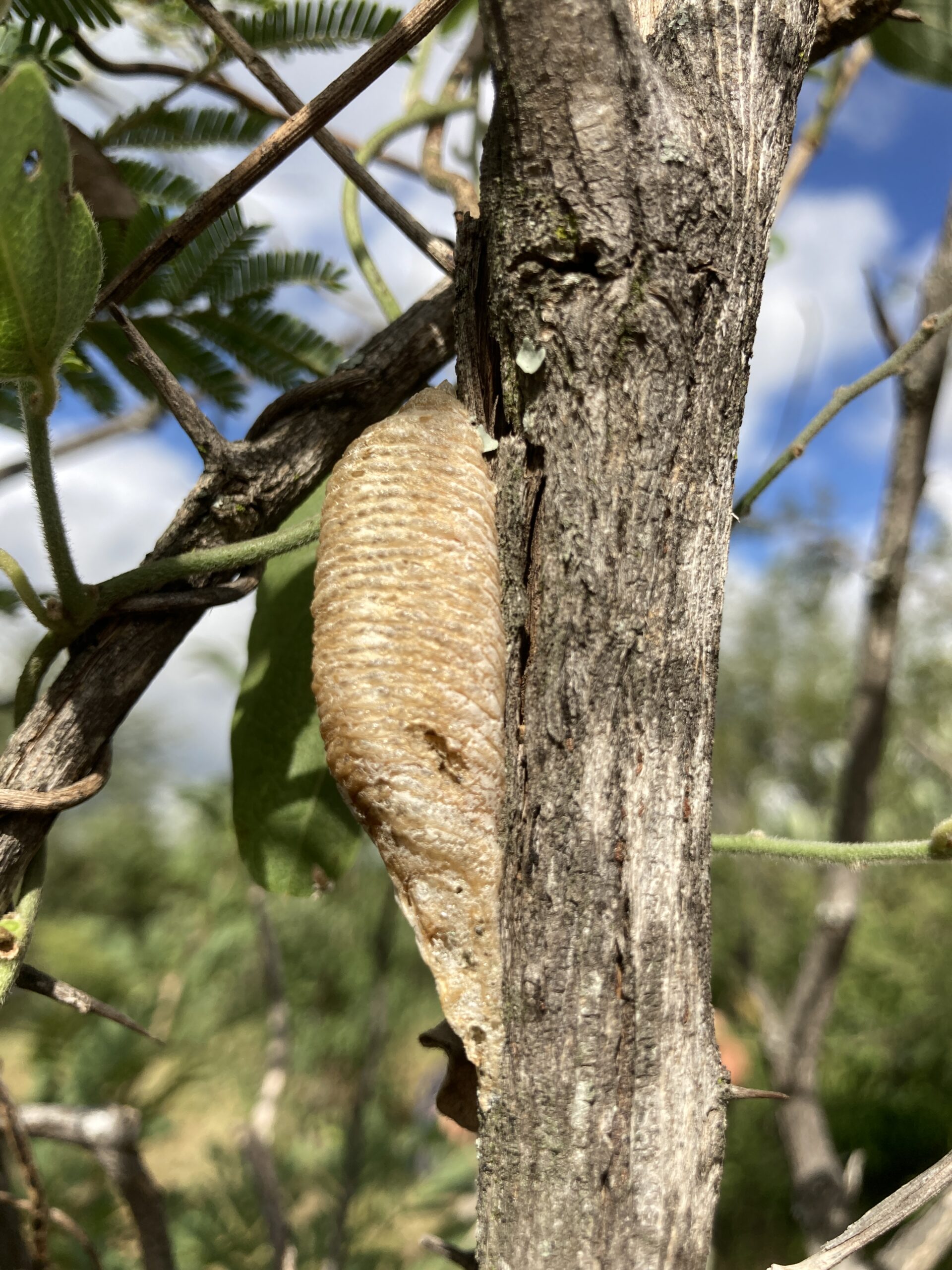
Answer: Sign can be tricky, until you know it. Answers included: some kind of insect nest such as wasps or hornets, praying mantis ootheca (egg case), bagworm, bee nest, and simply, “Don’t know.” All excellent answers. Juca, Erin, Brad, Justine, Mark, and Melinda all got this one, no doubt due to having seen it before. This is one you do not forget easily once you learn it, although there are many different species of them that all make different egg cases. This is a praying mantis ootheca (egg case), from a large-green mantid. Each one of those overlapping “fins” is a chamber in the hardened foam structure, and one egg is laid by the female in each chamber. There is a seam that runs down the outside, middle, just to the left of our view, that divides the ootheca in two, doubling the amount of fins and hence the number of eggs in their chambers. If the little ones hatch, they emerge through little pin-like holes at this seam. Many times, though, the oothecas are predated, especially by birds, and they appear ripped open, like this one (I’ve seen worse). Mantid oothecas are common across the world, so it’s a good one to know.
Question 8.
This photo comes from Kersey Lawrence in South Africa.
Who or what is it? Describe what you see.
Scroll down for the answer.
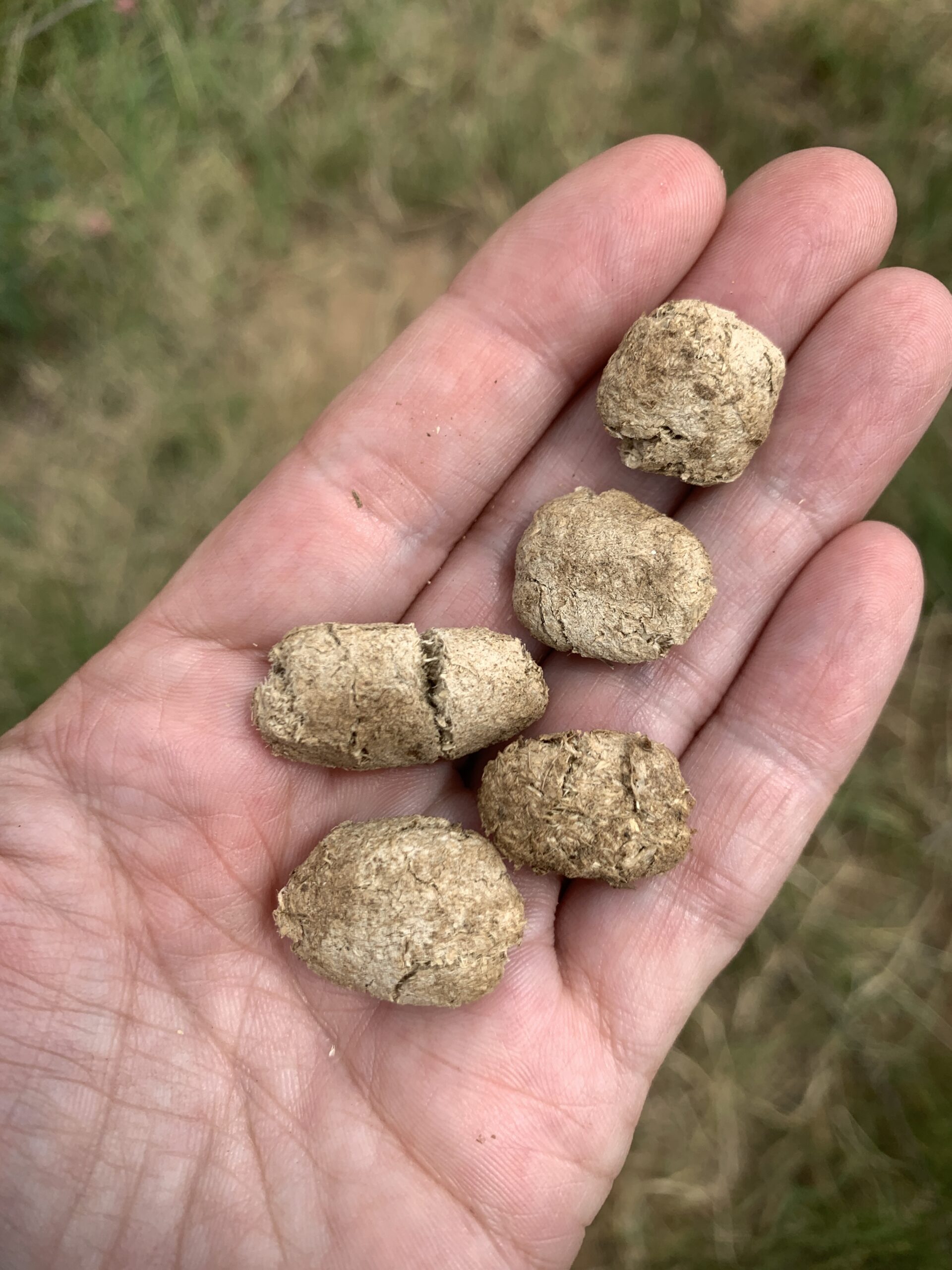
Answer: My favorite answer came from Mark, who said, “Springbok, because I have no idea.” Haha! Way to put yourself out there, Mark, and risk being wrong, because, that’s how we learn, isn’t it? In fact, many people said some sort of ungulate, like impala or deer. Indeed, this is an herbivore, as we can see the vegetation in those pellets. But, it’s not a ruminant, because we can still see large particles in the pellets. Ruminants have 4 chambers to their stomachs, and they “chew the cud,” in a combination chewing, regurgitations, more chewing, and different muscles of each stomach wall and digestive enzymes breaking vegetation down into almost powder. Another great guess was scrub hare, a lagomorph (rabbit or hare), which these do resemble, a lot. The feature that leads me away from scrub hare, though, is the size and shape of these pellets. The are bigger than scrub hare scats, which look like flattened, circular, yellow, M&M candies. These have the yellow color, but are long and more rectangular in shape. Lee describes them as “little suitcases.” Juca and Mix got this one. These are SPRINGHARE pellets! Springhares are not lagomorphs, they are large rodents, which live in communal burrows and move in a bipedal hop.
Question 9.
This photo comes from Kersey Lawrence at Boulder’s Beach in Cape Town, of South Africa.
Who or what is it? Describe what you see.
Scroll down for the answer.
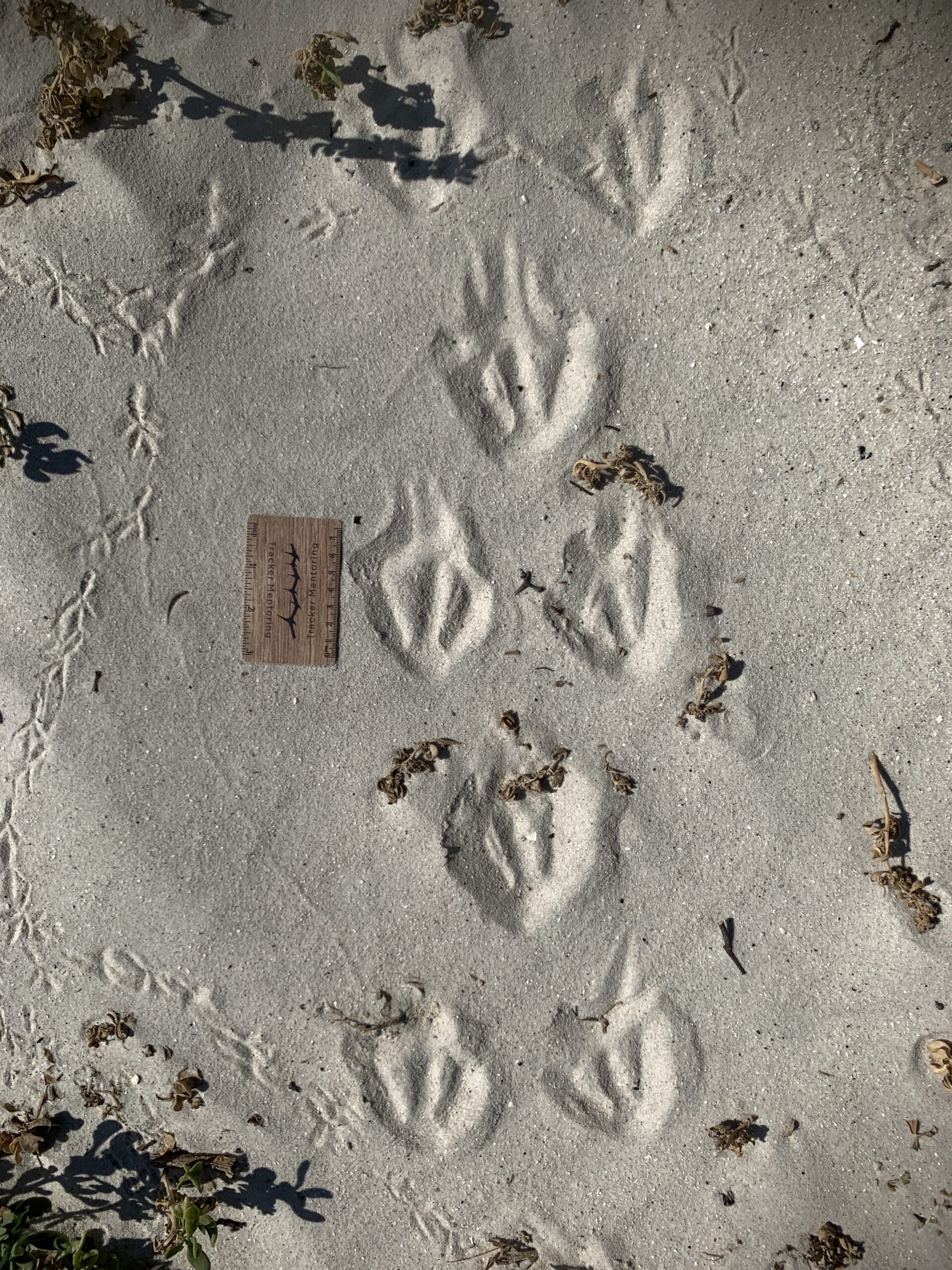
Answer: These funny, big bird tracks have a prominent metatarsal pad, and webbing! If you’d Googled webbed bird tracks at Boulder’s Beach, African Penguin would have come up immediately! Pete came close in his logic, with, “Wow—that is a weird one. Looks like maybe webbing connecting the rear of the tracks, about 4 inches long. Three toes visible—must be some kind of aquatic bird? Looks too small for a pelican or goose, maybe some kind of duck?? Tracks on the left are a much smaller bird—-some kind of pigeon?” And Erin was among those who got it right, with, “Penguin. They look like a webbed swimming birds feet and has the stride of an animal that has short legs.” Brad, Justine, Mix and Mark also came to penguin. The smaller bird track, which many of you also attempted, was a wagtail. Their tracks are very similar to doves and pigeons. I think there were at least 2 of them, overlapping in the trail, making it especially confusing.
Question 10.
This photo comes from Kersey Lawrence in South Africa.
Who or what is it? Describe what you see.
Scroll down for the answer.
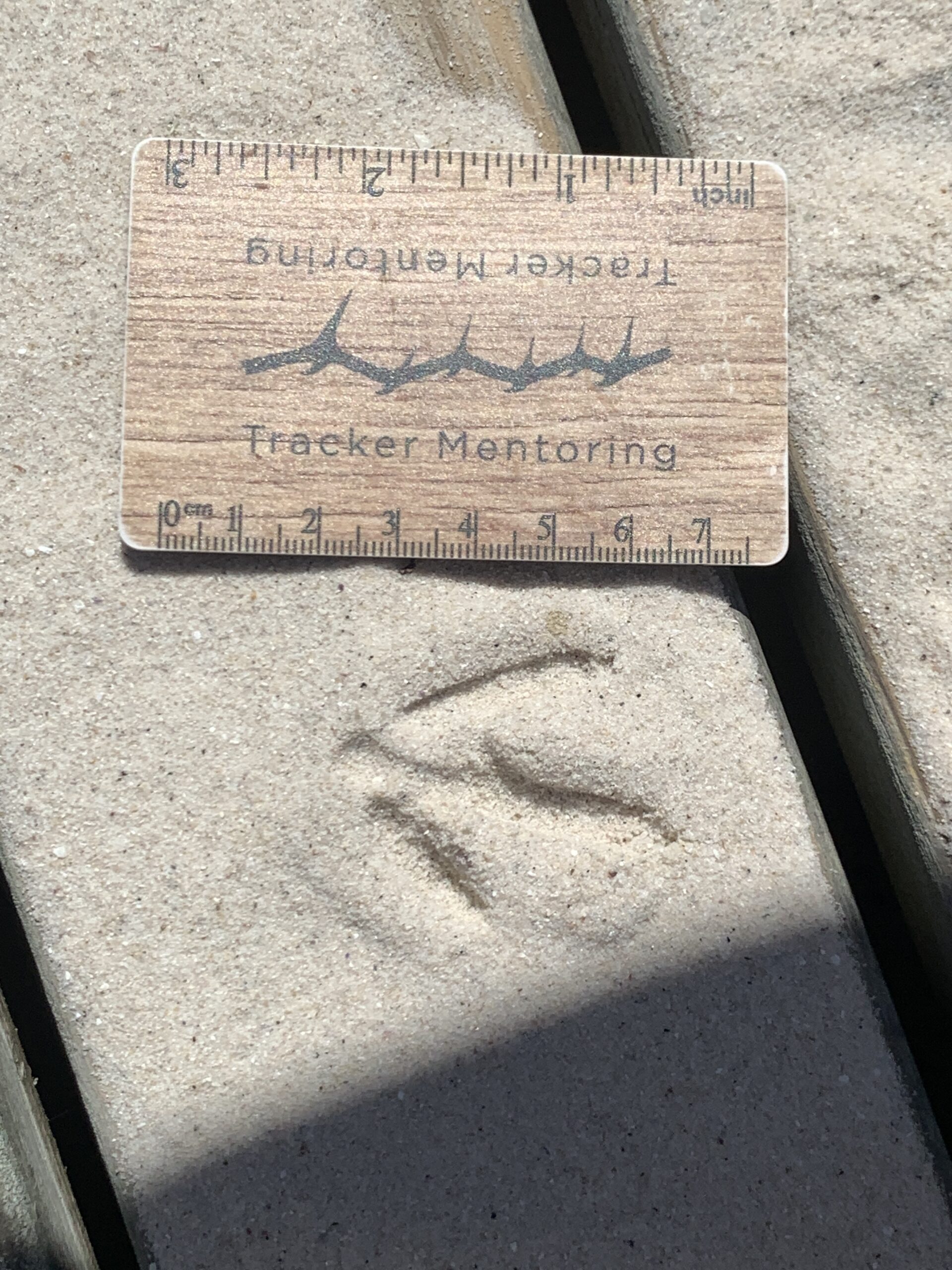
Answer: Justene got this one, with “Thick-knee, three toes forward and a small round pad.” If I remember correctly, these were Water Thick-knee tracks, but they are very similar to Spotted Thick-knee tracks and we sometimes can’t tell them apart, except sometimes by habitat – but I remember seeing both species here. So, thick-knee is a good answer. Everyone said some kind of bird, and most said some kind of bird that lives near water, such a s a duck, goose, or gull. Erin’s answer gave good details, with, “Duck. 3 toes, no hallux, the top outer toe curves inward. I don’t see webbing but it feels like those toes would be shaped to support webbing.” And Melinda also gave great information, with, “Track length 4.4cm. 3 thick, robust, segmented toes with possible slight webbing between T3 and T4. T2 shorter. Plumb-bob shaped metatarsal registering as deeply as the toes. No hallux. Claws immediately adjacent to end of toes. Korhaan.” Indeed, there is slight webbing down by where the toes join the metatarsal pad, especially between toes 3 and 4, so we don’t see a dramatic curve of the toes because they aren’t fully webbed. Thick-knees show this feature prominently in their tracks – as do lapwings with their more slender toes. Interestingly, thick-knees do have fat “knee” joints, and are also called “dikkops” in South Africa, which means, “Fat Head” in Afrikaans. Poor bird can’t get a break. You should Google them, they’re neat.
Please go to OriginalWisdom.com and subscribe to our email list if you’d like to continue to receive these quizzes, along with our news, updates, and calendar of programs for North America and Africa.
You can also view old quizzes on the Original Wisdom website under the Resources tab, in the Tracking Gallery.
We are building a tracking database as a resource for learners. CONTACT US if you would like to submit photos from your area of the world for these quizzes – it does not have to be Africa or North America.
One hundred percent of donations made in Brandon’s name are set aside to help provide for a high school or college student to travel to South Africa to participate in an Original Wisdom program. The student must have a strong passion for photography and/or wildlife tracking and be a part of a program or class that is learning about and working towards conservation.